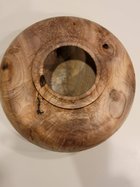Odie
Panning for Montana gold, with Betsy, the mule!
What I've come to believe is most people who don't turn on a lathe, have no concept of what size means to the effort required to produce a bowl. When they look at finished bowls, they automatically assume an 12" bowl takes much more effort than an 8" bowl. From my experience, and POV, the difference size makes in the total effort required is very minimal.....but, I consider the selling price of my bowls according to how I have concluded the average person will think.
Of course, size is only one element of of the total equation, but it's something people who don't know what the process involves, consider in a major way. This imprint on their psyche has to be addressed from their POV...and not from mine!
Most new turners will think: Hourly wage x hours, plus cost of materials = selling price......but, I've totally abandoned this concept.
One of the most important parts of the selling price equation is what I consider "artistic value". This, along with cost of materials. Size is a minor element, but most assuredly it is an element that most people consider in a major way......so, it must be included in the overall equation.
Also, the cost of certain woods will vary, depending on the current availability and desirability. There are times where these (mostly exotic) woods are more expensive, depending on the availability. Sometimes, it doesn't matter what you paid for your wood. It's more appropriate to consider the current rate, rather than what you paid years ago for it for an equivalent piece.
Your thoughts considered...
-----odie-----
Of course, size is only one element of of the total equation, but it's something people who don't know what the process involves, consider in a major way. This imprint on their psyche has to be addressed from their POV...and not from mine!
Most new turners will think: Hourly wage x hours, plus cost of materials = selling price......but, I've totally abandoned this concept.
One of the most important parts of the selling price equation is what I consider "artistic value". This, along with cost of materials. Size is a minor element, but most assuredly it is an element that most people consider in a major way......so, it must be included in the overall equation.
Also, the cost of certain woods will vary, depending on the current availability and desirability. There are times where these (mostly exotic) woods are more expensive, depending on the availability. Sometimes, it doesn't matter what you paid for your wood. It's more appropriate to consider the current rate, rather than what you paid years ago for it for an equivalent piece.
Your thoughts considered...
-----odie-----

